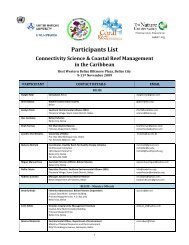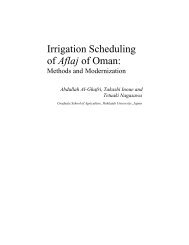The Global Water Crisis: Addressing an Urgent Security - Unu-inweh ...
The Global Water Crisis: Addressing an Urgent Security - Unu-inweh ...
The Global Water Crisis: Addressing an Urgent Security - Unu-inweh ...
You also want an ePaper? Increase the reach of your titles
YUMPU automatically turns print PDFs into web optimized ePapers that Google loves.
Introduction<br />
Cle<strong>an</strong> <strong>an</strong>d safe water is <strong>an</strong> import<strong>an</strong>t resource in building healthy <strong>an</strong>d progressive communities. By widening <strong>an</strong>d enh<strong>an</strong>cing<br />
access to cle<strong>an</strong> <strong>an</strong>d safe water, nine percent of the global burden of disease c<strong>an</strong> be alleviated <strong>an</strong>d 3.5 million deaths<br />
c<strong>an</strong> be prevented <strong>an</strong>nually (Prüss-Üstün et al., 2008). <strong>The</strong> socio-economic impacts from the prevention of water-related<br />
deaths <strong>an</strong>d diseases are tremendous; for each US $1 invested in improving access to water, communities reap benefits<br />
in productive time <strong>an</strong>d avoid<strong>an</strong>ce of treatment costs worth between US $2-$12 (Edwards, 2011).<br />
Today, safe water supply evades some 780 million people, or approximately 11% of the world’s population (UNICEF <strong>an</strong>d<br />
World Health Org<strong>an</strong>ization, 2012). From <strong>an</strong> overall perspective, this is a marked improvement from 1990, where almost<br />
one-quarter of the global population did not have access to cle<strong>an</strong> <strong>an</strong>d safe water. However, these improvements were<br />
mostly made in East <strong>an</strong>d South Asia; countries in the sub-Sahar<strong>an</strong> Africa <strong>an</strong>d Pacific regions still lack adequate access, with<br />
each region registering water supply coverage of 61% <strong>an</strong>d 54% respectively (UNICEF <strong>an</strong>d WHO, 2012). It is no coincidence<br />
that cholera, a disease that thrives where there are deficits in water <strong>an</strong>d s<strong>an</strong>itation, is prevalent in both these regions 1 .<br />
As efforts continue to connect the growing global population to safe water supply, considerations need to be afforded to<br />
demographic, economic <strong>an</strong>d social pressures. <strong>The</strong>se pressures not only affect access, but also the qu<strong>an</strong>tity <strong>an</strong>d quality<br />
of water supplies. Mounting pressures could cause increases in a country’s virtual water need, that is, the water used to<br />
produce goods <strong>an</strong>d services. Higher consumption of virtual water not only affects the sustainability of access of communities<br />
already linked to water supplies, but also the availability of water to communities that have not gained access to water<br />
as resources are diverted to meet other existing dem<strong>an</strong>ds (see Box 1 on <strong>Water</strong> Shortages in China).<br />
This paper examines the linkages between water security (in terms of qu<strong>an</strong>tity <strong>an</strong>d quality) <strong>an</strong>d hum<strong>an</strong> health, summarizes<br />
potential health impacts from water deficits, <strong>an</strong>d examines the implications for socio-economic development.<br />
Box 1. <strong>Water</strong> Shortages in China<br />
China faces water shortages from the singular <strong>an</strong>d interactive effects of high water losses through supply<br />
infrastructure, effluent contamination, <strong>an</strong>d rising water dem<strong>an</strong>d from the agricultural sector. <strong>The</strong>se shortages<br />
greatly affect food production, the largest water user in China (constituting 71% of China’s total freshwater<br />
dem<strong>an</strong>d) (Amarasinghe et al., 2005).<br />
As a workaround solution to fulfill domestic dem<strong>an</strong>d for food, China has begun to establish farms in Argentina,<br />
Australia, Brazil, Kenya, Russia <strong>an</strong>d Zimbabwe (Economy, 2011). China’s virtual water consumption has clearly<br />
grown, but the burden of meeting this dem<strong>an</strong>d has been shifted to other countries.<br />
1. <strong>Water</strong> Quality <strong>an</strong>d Health<br />
Rivers, lakes, <strong>an</strong>d aquifers are vulnerable to pollut<strong>an</strong>ts, which intensify the occurrence of water-related diseases by impairing<br />
water use, <strong>an</strong>d introduce new health risks associated with the presence of pollut<strong>an</strong>ts in the hum<strong>an</strong> body. Pollut<strong>an</strong>ts c<strong>an</strong><br />
be broadly categorized as hum<strong>an</strong>-induced, or naturally occurring. Hum<strong>an</strong>-induced pollut<strong>an</strong>ts enter waterways through<br />
unmitigated discharge of untreated or insufficiently treated domestic <strong>an</strong>d industrial wastewater (point sources), <strong>an</strong>d<br />
agricultural run-off (non-point source). Pollut<strong>an</strong>ts that occur naturally, also termed geogenic pollut<strong>an</strong>ts, are usually found<br />
in groundwater. <strong>The</strong> concentration of geogenic pollut<strong>an</strong>ts in groundwater resources may be aggravated by hum<strong>an</strong> activities<br />
that infiltrate or fracture the surrounding rock or substrata.<br />
1 In 2009, of the 206,183 cases of cholera reported worldwide, 98.7% cases occurred in sub-Sahar<strong>an</strong> Africa, with the remainder occurring in the<br />
Pacific (World Health Org<strong>an</strong>ization, 2011b).<br />
<strong>Water</strong> <strong>an</strong>d Health <strong>Security</strong><br />
Part 2<br />
77




